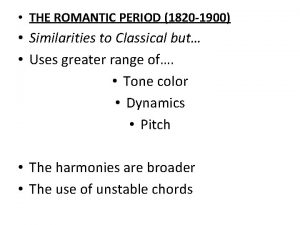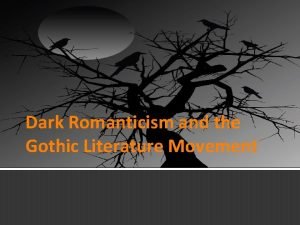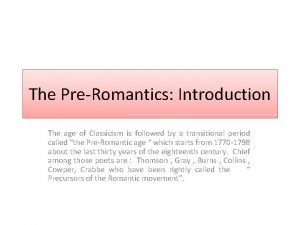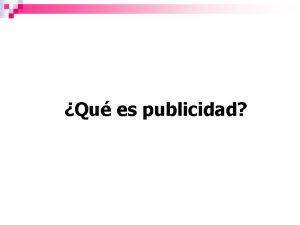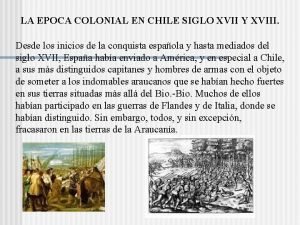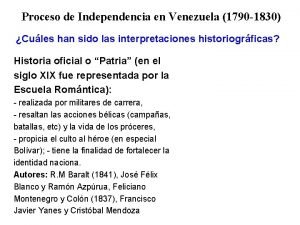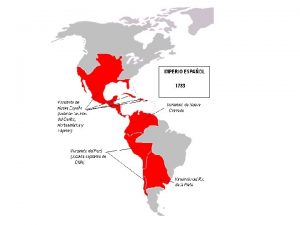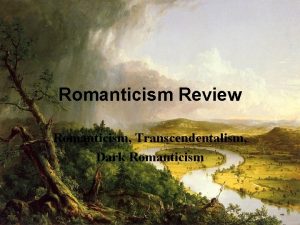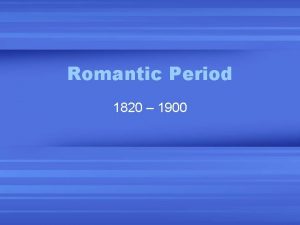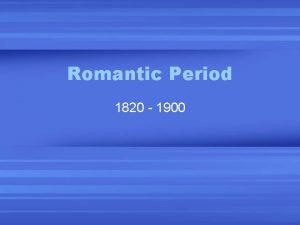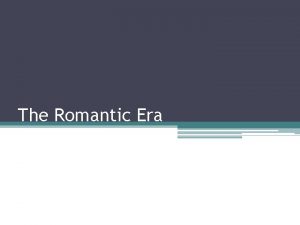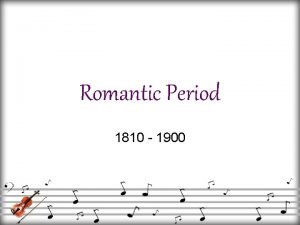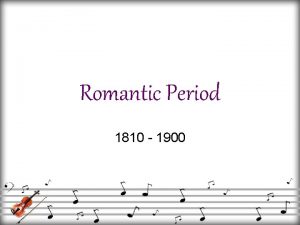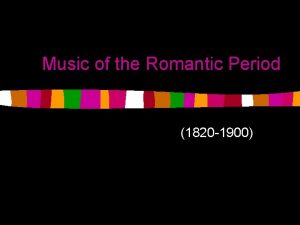Romantic Period ca 1810 1900 Romanticism is a








- Slides: 8

Romantic Period (ca 1810 -1900) Romanticism is a term applied to music from ca 1810 to 1900 and is borrowed from a movement from the end of the 18 th century which was used to describe the beginnings of new ideas in the arts. Romantic composers created greater freedom of form and design in their music than in the previous Classical period. Romantic composers had a wide interest in all forms of art and befriended artists, writers, poets, composers. These friendships often provided the inspiration for the composition of new music as the composers experimented with sound to create the feelings of: Emotions - the story of poems - the description of the countryside - fantasies and dreams – love – war - rivers and lakes and in fact any idea that inspired the composer.

The Romantic orchestra grew in size and added piccolo, trombone and more varied percussion and more developed instruments.

• Romantic composers wrote long, singing, emotional melodies for solo instruments, vocalists and large Romantic orchestra. • These melodies were supported by unusual, large, chromatic chords or discords and frequent use of modulations.

Some Romantic composers JOHANNES BRAHMS (1833 – 1897) German 4 Symphonies St. Anthony Variations Hungarian Dances Chamber Music Piano Music Organ Music Requiem ‘Alto’ Rhapsody 200 Songs / Lieder FRANZ LISZT (1811 – 1886) Hungarian Symphonic Poems [Prometheus / Les Preludes] Piano Music [Hungarian Rhapsody] FREDERIC CHOPIN (1810 – 1849) Polish Piano Music Preludes Etudes Liebestraume Ballades Franz Liszt - Les préludes, symphonic poem No. 3 Mazurkas Nocturnes Piano Concertos

‘Leftover’ Concepts N 3 – N 5 • Contrary motion - Two parts move in opposite directions, eg as one part ascends the other part descends. • • Atonal – no feeling of key, major or minor. It is very dissonant, and it will lack a 'nice' melody and accompaniment. Cluster - A term used to describe a group of notes, which clash, played together. Flutter tonguing - Rolling your 'r's whilst playing a brass or woodwind instrument. Cross rhythms - Contrasting rhythms played at the same time or • http: //www. educationscotland. gov. uk/nqmusic/national 5/concepts/crossrhythm. asp • • Blues / Rock / Pop / Rock’n’Roll Reggae - Reggae music was developed in the late 1960 s in Jamaica. It has quite a distinctive sound and has the characteristic of strong accents on the 2 nd and 4 th beats of the bar. African Music - http: //www. educationscotland. gov. uk/nqmusic/national 4/concepts/africanmusic. asp Gospel - Music written with religious lyrics, often in praise or thanksgiving to God. Gospel has its origins in Afro-American culture. • • played with unusual emphasis on notes.

• Minimalist - A development in the second half of the 20 th century based on simple rhythmic and melodic figures which are constantly repeated with very slight changes each time. http: //www. factmag. com/2010/02/01/a-brief-history-of-minimalism/ • Further info: http: //www. bbc. co. uk/schools/gcsebitesize/music_20 th_century/reich 3. shtml • Latin American - Dance music from South America. Percussion instruments provide lively off-beat dance rhythms. (Salsa, Samba, Paso Doble etc • Indian Music: Sitar - A plucked, stringed instrument from India. It's basically an Indian guitar – easy to remember because sitar rhymes with guitar. • Tabla - Indian drums often used to accompany the sitar. http: //www. educationscotland. gov. uk/nqmusic/national 5/concepts/indian. asp • Guiro / Castanets / Bongo drums • Xylophone / Glockenspiel Steve Reich – Six marimbas

• Ragtime - A style of dance music which became popular at the end of the 19 th century and which helped to influence jazz. It features a strongly syncopated melody (meaning the notes don’t always fall on the beat) against a steady, simple accompaniment played as a vamp, often played on piano, eg Scott Joplin rags. http: //www. youtube. com/watch? v=kymfe. Lpumn 4&feature=results_main&playnext=1&list=PL 4 CC 1 EE 2 F 98 C 09 B 0 E • Jazz - At first this was music created by black Americans in the early 20 th century. Features of the music may include syncopation and improvisation. http: //www. youtube. com/watch? v=Xrg. P 1 u 5 YWEg • Swing - A jazz style which started in the 1930 s and was performed by a big band. The numbers and types of instruments in the big bands increased during this period, through the influence of swing. • http: //www. educationscotland. gov. uk/nqmusic/national 4/concepts/swing. asp • Middle 8 - In popular music, a section which provides a contrast to the opening section. It is often eight bars long. Beatles ‘Help ‘ - Middle 8 starts with the words: Help me if you can …’ • Brass Band – Brass instruments and percussion section. • Wind Band – Woodwind, brass and percussion instruments. • Distortion - An electronic effect used in rock music to colour the sound of an electric guitar. It gives a 'fuzzy' sound rather than the usual clean sound. • Reverb - An electronic effect which can give the impression of different hall acoustics. For example, reverb can make a piece of music sound as if the performance is taking place in a cathedral. • • • Pan pipes http: //www. youtube. com/watch? v=YZ 9 XMT 5 q. XXU&feature=related Muted / con sordino – Using a mute changes the sound normally produced on an instrument. http: //www. educationscotland. gov. uk/nqmusic/national 5/concepts/consordinomuted. asp Pitch bend - Changing the pitch of a note, for example by pushing a guitar string upwards. Sound example: Rossini ‘Cat duet’

• Countermelody – A melody played against the main melody http: //www. educationscotland. gov. uk/nqmusic/national 5/concepts/countermelody. asp • Descant (Voice) – A countermelody which is sung and is sung above the main melody • Sound example: Silent night descant • Literacy: repeat signs, 1 st & 2 nd time bar, grouped semi quavers, paired quavers, Accidentals, flats, sharps, naturals • Scales and Key Signatures: C Major: C, D, E, F, G, A, B, C • G Major: G, A, B, C, D, F#, G - F Major: F, G, A, Bb, C, D, E, F • A Minor: A, B, C, D, E, F, G, A
 Romantic period 1820 to 1900
Romantic period 1820 to 1900 This period lasted from approximately 1775 - 1825
This period lasted from approximately 1775 - 1825 The romanticism (1795 — 1835) what is romanticism
The romanticism (1795 — 1835) what is romanticism Subcategories of romanticism
Subcategories of romanticism Pre romantic writers
Pre romantic writers Falacias medios de comunicacion
Falacias medios de comunicacion Vestimenta de 1810
Vestimenta de 1810 Causas de la caida de la segunda republica
Causas de la caida de la segunda republica Independencia de chile patria vieja
Independencia de chile patria vieja
